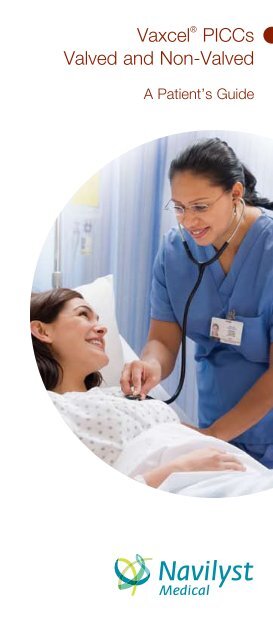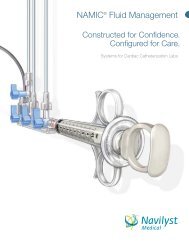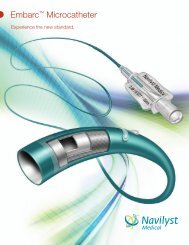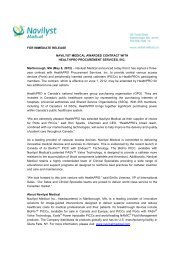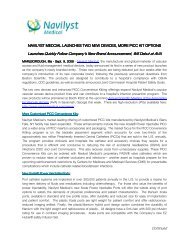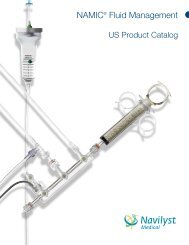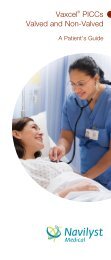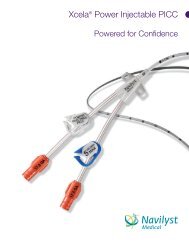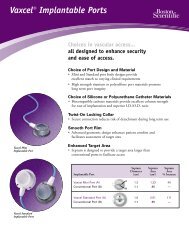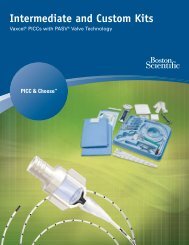Vaxcel® PICCs Valved and Non-Valved - Navilyst medical
Vaxcel® PICCs Valved and Non-Valved - Navilyst medical
Vaxcel® PICCs Valved and Non-Valved - Navilyst medical
Create successful ePaper yourself
Turn your PDF publications into a flip-book with our unique Google optimized e-Paper software.
Vaxcel ® <strong>PICCs</strong><strong>Valved</strong> <strong>and</strong> <strong>Non</strong>-<strong>Valved</strong>A Patient’s Guide
Information about yourVaxcel ® PICC is availableby calling the <strong>Navilyst</strong>Medical VascularAccess Information Line800.513.6876
What is a PICC ?A PICC is a Peripherally Inserted Central Catheter, along thin tube that is placed into a vein <strong>and</strong> threadeduntil the tip is in a very large vein in your chest. ThePICC may be used to give medicines <strong>and</strong> otherfluids, such as nutrition <strong>and</strong> blood products, intothe vein. This is called IV or intravenously. Unlike theshort IV lines you may have had placed in your h<strong>and</strong>or arm, a PICC may be in your arm many weeksor months. It may also be possible to take bloodsamples from your PICC to be used for special tests.There are a variety of <strong>PICCs</strong> available. Some havea valve, while others do not. Vaxcel ® <strong>PICCs</strong> withPASV ® Valve Technology are catheters that have avalve located in an area at the end of the cathetercalled the hub. <strong>Valved</strong> catheters generally do nothave clamps like non-valved catheters, such asVaxcel <strong>PICCs</strong>. Generally, both types of catheters areplaced <strong>and</strong> cared for in a similar manner.Your PICC is a hollow, flexible tube that has one or twoopenings or lumens.Each lumen may have a valve located in the catheter hubor may have a clamp.Each lumenopens at thisend of thecatheter.2
How is the PICC placed?Your PICC will be placed by a specially trainedhealthcare provider. This may be done in yourroom in the hospital, a clinic, the x-ray departmentor other location. You will be asked to lie flat, oryou may be in a low sitting position with your armstraight. It is important that you be as comfortableas possible <strong>and</strong> that you do not move your armduring the PICC placement.Your arm will be cleaned, <strong>and</strong> you will be coveredwith special cloths to keep the area as clean aspossible—this is called sterile technique.The person placing your PICC will wear a mask,gown, gloves <strong>and</strong> hat. This is to protect you <strong>and</strong>keep the area clean during the procedure.The catheter is inserted so thatthe tip rests near your heart.This is your insertion site whichwill be covered with a dressing.continued on next page3
How do I care formy Vaxcel ® PICC ?Your PICC will need to be cared for <strong>and</strong> kept clean.Care will include changing the dressing any timeit becomes loose, soiled or wet <strong>and</strong> at least onetime every week. This may be done by a healthcareprovider, or at the suggestion of the healthcareprovider, by you, a family memberor friend that has beentaught how the dressingis changed.A sterile end capwill be placed onthe catheter hub.This keeps thecatheter closedwhen not beingused. Certain endcaps allow accessto the catheter withoutremoving it from the hub. Some<strong>PICCs</strong> have one opening (lumen) <strong>and</strong> others mayhave two lumens. Notify your healthcare providerif your end cap(s) becomes loose, comes off or isleaking. The end caps should be changed at leastone time per week, or as often as your healthcareprovider suggests.Before any medicine or fluid is given, or blood isdrawn, the end cap <strong>and</strong>/or hub must be cleanedwith a special cleaning solution. This is done toprevent germs from getting into your catheter. Yourhealthcare provider will teach you how to clean theend cap.5
Should I limit my activitieswhile I have this PICC ?Bending your arm, reaching <strong>and</strong> doing everydayactivities should not harm your PICC.You should not lift heavy objects,or carry objects held in the bendof your arm that may put strainon the PICC or the dressing.If your healthcare providerapproves, you may take ashower or bath with the PICCin place as long as you coverthe PICC <strong>and</strong> dressing with plasticwrap, a plastic bag or material that willkeep it from getting wet. You should NOT do otheractivities, like swimming, that may get the catheteror dressing wet. A wet dressing or catheter may putyou at risk for infection.Notify your healthcare provider or seek <strong>medical</strong>attention if you have:• Redness, soreness or swelling at the PICCinsertion site or on your arm• Fever, chills or vomiting• Any problems with your catheter whilecaring for it• Difficulty giving medications, or being ableto draw blood• A catheter that becomes damaged in anyway, leaks, is torn or broken6
RecommendedFlushing Protocols(to be completed by your healthcare provider)Solution ______________________________________Volume/Lumen_ _______________________________Schedule_ ____________________________________Additional Instructions_____________________________________________________________________________________________________________________________________________________________________________________________________________________________________________________________________________________________________________________________________________________________________________________________________________________________________________________________________________________________________________________________________________________________________________________________________________________________________________________________________________________________________________________________________________________________________________________________7
VAXCEL PICCS VALVED AND NON-VALVEDINDICATIONS: The Vaxcel ® PICC with PASV ® Valve Technology is indicated for use in establishingperipheral access to the central venous system for administration of fluids including, but not limitedto, hydration agents, antibiotics, chemotherapy, analgesics, nutritional therapy <strong>and</strong> blood products. Itis also indicated for blood specimen withdrawal. This product is intended for central venous access inadults, children <strong>and</strong> infants who require intravenous (IV) therapy.The Vaxcel PICC catheter system is designed for use when central venous catheterization orprolonged intravenous administration of fluids, medications, <strong>and</strong>/or nutritional therapy is prescribed.A variety of insertion sites may be utilized, depending upon the patient involved <strong>and</strong> the catheter sizeselected. While any vessel suitable for insertion may be used, the basilic vein is the most commonlyused vein. Location of the distal catheter tip must provide maximum dilution for whatever therapybecomes necessary <strong>and</strong> assurance of a continued, uncompromised vascular access.CONTRAINDICATIONS: Venous thrombosis in all or any portion of the vein where the catheteris expected to reside; conditions that impede venous return from the extremity such as paralysisor lymphedema after mastectomy; orthopedic or neurological conditions affecting the extremity;anticipation or presence of dialysis grafts or other intraluminal devices such as pacemakers;hypercoagulopathy unless considerations are made to place the patient on anticoagulation therapy;inadequate antecubital veins; pre-existing skin surface or subsurface infection at or near theproposed catheter insertion site; anatomical distortions from surgery, injury or trauma; anatomicalirregularities (structural or vascular) which may compromise catheter insertion or catheter careprocedures.PRECAUTIONS: Care should be taken when using alcohol or acetone. Allow for complete drying ofalcohol or acetone during routine care <strong>and</strong> maintenance. For Vaxcel <strong>PICCs</strong>, do not use acetone oralcohol-based iodine solutions on any part of the catheter tubing. The Vaxcel PICC with PASV ValveTechnology is designed for use with a “direct-to-hub” connection technique. Apply a sterile end capon the hub to prevent contamination when not in use. Use of a needle longer than 3/4” (1.90cm)may cause damage to the valve. Do not exceed 40 psi/276 kPa (207 cmHg) on infusion pumps whenadministering fluids.CAUTION: Federal Law (USA) <strong>and</strong> governing law outside the USA restrict these devices to sale by oron the order of a physician. Refer to Directions for Use for Complete Instructions.Healthcare providers should refer to Directions for Use for complete instructions.8
TRAVEL CARDAlways carry your Vaxcel ® PICCCatheter Travel Card with you.This card has important information aboutyour catheter that healthcare providers willneed to care for you.Fill out your personal information in the areasprovided. Your Travel Card is convenientlysized to fit in a wallet.TRAVEL CARD26 Forest StreetMarlborough, MA 01752Customer Service: 800.833.9973PATIENT NAME: ______________________________________________________________TELEPHONE: (W) __________________________ (H) ________________________________EMERGENCY CONTACT: ______________________________________________________TELEPHONE: (W) __________________________ (H) ________________________________PHYSICIAN NAME: ____________________________________________________________TELEPHONE: _________________________________________________________________INSERTION DATE: _________________________________ 3FSL 4FSL 5FSL 5FDL 6FDLTRIMMED LENGTH: ________________________________ LOT NO.: __________________
Vaxcel ® Peripherally InsertedCentral Catheter (PICC)TRAVEL CARDSupport for this product <strong>and</strong> other <strong>Navilyst</strong> Medicalvascular access products is available by calling the<strong>Navilyst</strong> Medical Vascular Access Information Line.800.513.6876
<strong>Navilyst</strong> Medical, Inc.26 Forest StreetMarlborough, MA 01752www.navilyst<strong>medical</strong>.comFor more information, call800.833.9973Persons depicted in this brochureare models <strong>and</strong> includedfor illustrative purposes only.© 2008 <strong>Navilyst</strong> Medical, Inc., or its affiliates.All rights reserved.NAVPE110 / 18M / 11/08


